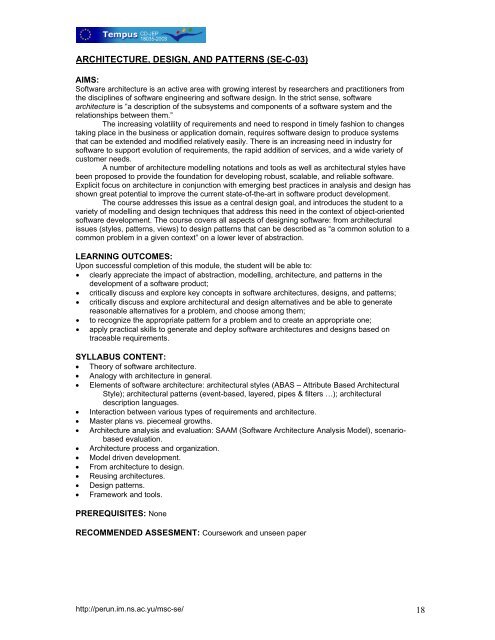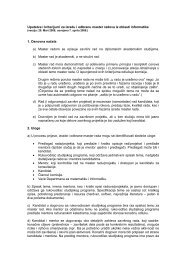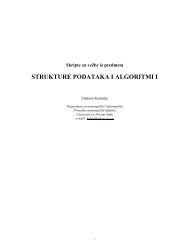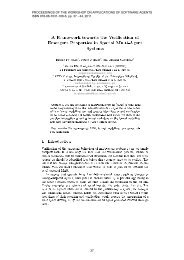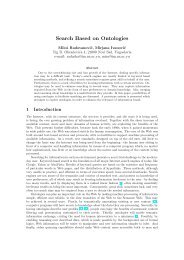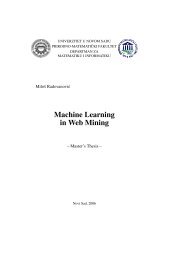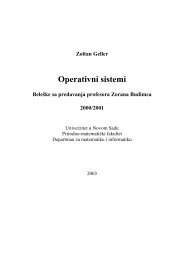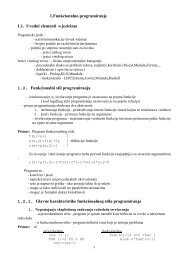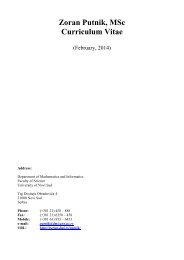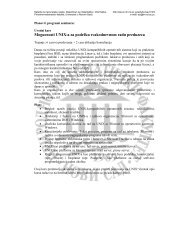Full document describing all aspects of the curriculum, release 2 (pdf)
Full document describing all aspects of the curriculum, release 2 (pdf)
Full document describing all aspects of the curriculum, release 2 (pdf)
You also want an ePaper? Increase the reach of your titles
YUMPU automatically turns print PDFs into web optimized ePapers that Google loves.
ARCHITECTURE, DESIGN, AND PATTERNS (SE-C-03)AIMS:S<strong>of</strong>tware architecture is an active area with growing interest by researchers and practitioners from<strong>the</strong> disciplines <strong>of</strong> s<strong>of</strong>tware engineering and s<strong>of</strong>tware design. In <strong>the</strong> strict sense, s<strong>of</strong>twarearchitecture is “a description <strong>of</strong> <strong>the</strong> subsystems and components <strong>of</strong> a s<strong>of</strong>tware system and <strong>the</strong>relationships between <strong>the</strong>m.”The increasing volatility <strong>of</strong> requirements and need to respond in timely fashion to changestaking place in <strong>the</strong> business or application domain, requires s<strong>of</strong>tware design to produce systemsthat can be extended and modified relatively easily. There is an increasing need in industry fors<strong>of</strong>tware to support evolution <strong>of</strong> requirements, <strong>the</strong> rapid addition <strong>of</strong> services, and a wide variety <strong>of</strong>customer needs.A number <strong>of</strong> architecture modelling notations and tools as well as architectural styles havebeen proposed to provide <strong>the</strong> foundation for developing robust, scalable, and reliable s<strong>of</strong>tware.Explicit focus on architecture in conjunction with emerging best practices in analysis and design hasshown great potential to improve <strong>the</strong> current state-<strong>of</strong>-<strong>the</strong>-art in s<strong>of</strong>tware product development.The course addresses this issue as a central design goal, and introduces <strong>the</strong> student to avariety <strong>of</strong> modelling and design techniques that address this need in <strong>the</strong> context <strong>of</strong> object-orienteds<strong>of</strong>tware development. The course covers <strong>all</strong> <strong>aspects</strong> <strong>of</strong> designing s<strong>of</strong>tware: from architecturalissues (styles, patterns, views) to design patterns that can be described as “a common solution to acommon problem in a given context” on a lower lever <strong>of</strong> abstraction.LEARNING OUTCOMES:Upon successful completion <strong>of</strong> this module, <strong>the</strong> student will be able to:• clearly appreciate <strong>the</strong> impact <strong>of</strong> abstraction, modelling, architecture, and patterns in <strong>the</strong>development <strong>of</strong> a s<strong>of</strong>tware product;• critic<strong>all</strong>y discuss and explore key concepts in s<strong>of</strong>tware architectures, designs, and patterns;• critic<strong>all</strong>y discuss and explore architectural and design alternatives and be able to generatereasonable alternatives for a problem, and choose among <strong>the</strong>m;• to recognize <strong>the</strong> appropriate pattern for a problem and to create an appropriate one;• apply practical skills to generate and deploy s<strong>of</strong>tware architectures and designs based ontraceable requirements.SYLLABUS CONTENT:• Theory <strong>of</strong> s<strong>of</strong>tware architecture.• Analogy with architecture in general.• Elements <strong>of</strong> s<strong>of</strong>tware architecture: architectural styles (ABAS – Attribute Based ArchitecturalStyle); architectural patterns (event-based, layered, pipes & filters …); architecturaldescription languages.• Interaction between various types <strong>of</strong> requirements and architecture.• Master plans vs. piecemeal growths.• Architecture analysis and evaluation: SAAM (S<strong>of</strong>tware Architecture Analysis Model), scenariobasedevaluation.• Architecture process and organization.• Model driven development.• From architecture to design.• Reusing architectures.• Design patterns.• Framework and tools.PREREQUISITES: NoneRECOMMENDED ASSESMENT: Coursework and unseen paperhttp://perun.im.ns.ac.yu/msc-se/ 18


